January 09, 2014
Presenting the Kerbasus-Kermes III
Greetings, ladies and gentlekerbs, and welcome to today's tour of the Kerbal Space Center Vehicle Assembly Building. The focus of today's tour will be the rocket behind me, the Kerbasus-Kermes III.
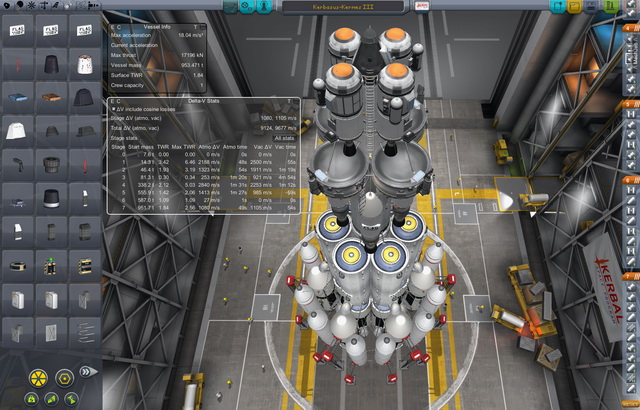
As the name implies the Kerbasus-Kermes III rocket is the third iteration of this platform. It consists of a Kermes lander and return vehicle, an interplanetary transfer stage, and then a three stage Kerbasus launch vehicle. This stack will be moving out to the launch pad this evening in preparation for Jebediah Kerman's mission to Duna.Now we'll go over the vehicles in detail. Starting at the very top, we have the Kermes return vehicle. The Kermes III is a dramatic improvement over the earlier Kerbysseus and the Kermes prototypes. It has four science bays with 5 instruments apiece, guaranteeing that our researches will have plenty of data available after the mission.Each science bay is mounted atop an engine pod, and the engine/science pods are mounted around a central fuel tank. We've equipped the Kermes III with some of the most efficient engines we've yet developed, and the combined thrust from the four engines is enough to give even this heavy vehicle the lift it needs to escape Duna.Finishing off the lander, we have an array of solar panels, some landing lights, access ladders, a large array of parachutes designed to slow it down both in Duna's and Kerbin's atmospheres, and of course the command capsule that will keep Jebediah Kerman protected from the environment during his multi-year journey.
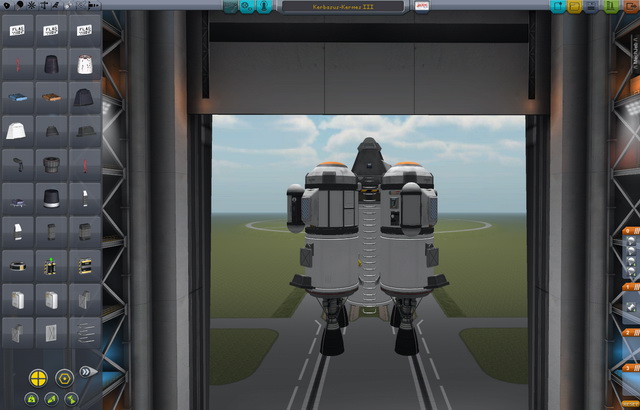
With the earlier Kerbysseus lander, destined for small local bodies like the Mun and Minmus, it was simple to make a single vehicle that could handle all the burns from parking orbit over the target through landing, launch, and a transfer orbit back to Kerbin's atmosphere. Duna presents a much greater challenge, having very little atmospheremaking parachutes insufficient, yet having enough gravity that landing and then launch back to orbit require significant amounts of thrust and fuel. The most efficient way to solve this problem is to design one craft to handle the de-orbit burn and landing, and then another craft for the return. We've already shown you the return vehicle,now let's look at the lander.The Kermes lander stage, like the return vehicle, consists of a central fuel tank ringed by four engine pods. For the lander, we use larger and more powerful engines. This gives us the extra thrust we need to ensure we get our velocity down and don't add another crater to the surface of Duna, but their greater size also provides a stablelanding platform. The lander also carries additional parachutes, more lights, and more solar panels.
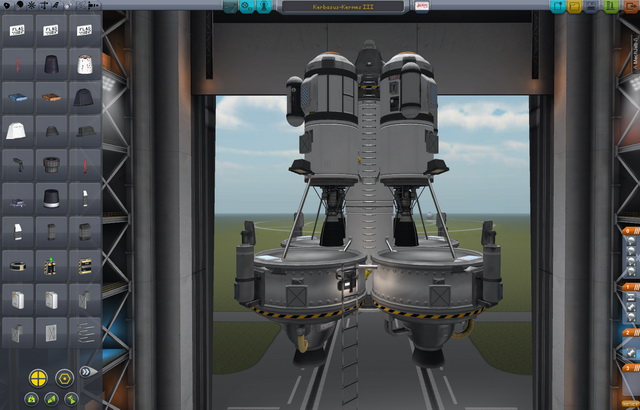
To move the Kermes lander and return vehicles from Kerbin parking orbit to a Duna parking orbit, we use the interplanetary transfer vehicle. Like the return vehicle and lander, the transfer vehicle is a central fuel tank encircled by four engines. Following our trend, this stage features more fuel capacity. The transfer vehicle engines are actually less powerful than those of the lander or return vehicle, but they are highly efficient, letting us get the most energy out of every bit of fuel. Since the transfer vehicle is nominally only used for two burns that are not time sensitive, this is an excellent trade-off. And we've learned how to properly use nuclear engines now, so there won't be any repeats of that unfortunate incident where we wiped out all the electronics in North Kerbica. And we're pretty sure we've shielded things well enough that Jeb won't have to worry about two headed children.
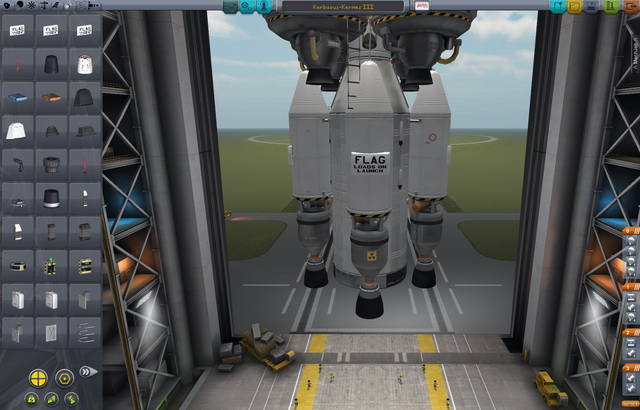
With the low thrust of the interplanetary transfer stage, it's not well suited for boosting into Kerbin orbit, so the Kerbasus launcher is designed to ensure that we can get the vehicle into parking orbit without relying on the transfer stage for any final adjustments. Our engineers greatly enjoyed the challenge of producing this launch vehicle, as each time they came up with a design that they was overpowered for the job, we actually found that it needed yet more power. The final result consists of two central core stages, with the lower stage being encircled by two rings of boosters.The topmost stage of the launcher consists of seven very large fuel tanks in a circle, each one possessing a very powerful dual rocket engine and an auxillary radial nozzle. With the combined mass of this stage, the transfer vehicle, and the lander above, reaction wheels are a less than ideal mechanism for keeping the rocket precisely on course, so we've added manuevering rockets around the perimeter. It is expected that this stage will take over after the rocket reaches it's original apoapsis, providing the thrust to convert that initial sub-orbital trajectory into a circular parking orbit.
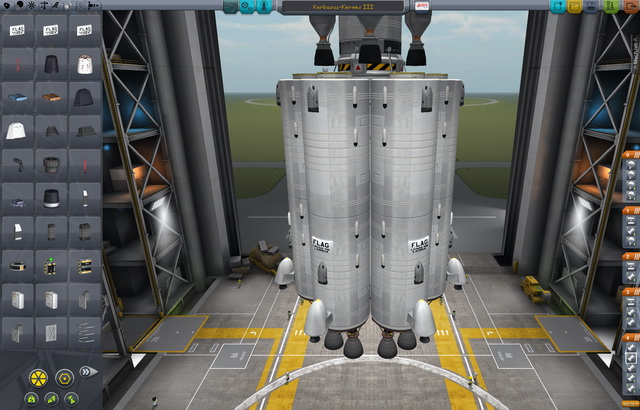
The core launch stage is very similar to the stage above it, consisting of seven large fuel tanks in a circle, each with the same dual rocket engine and radial engine. Since this stage is expected to operate from launch all the way up to the edge of the atmosphere, it is equipped with both winglets for aerodynanic control and reaction control thrusters for manuevering control at high altitude. The outboard radial rockets are configured to remain idle during the initial boost stage, only igniting after the booster stages separate.Outboard of the seven core tanks, an additional six tanks are placed in a ring as boosters. These consist of the same tank and main engines, but lack the radial thruster or control systems. These boosters thrust from launch until they run out of fuel at approximately 10,000 meters.The final stage is a ring of six solid rocket boosters. These also thrust from launch until just before 10,000 meters, and are decoupled just seconds before the main launch boosters.
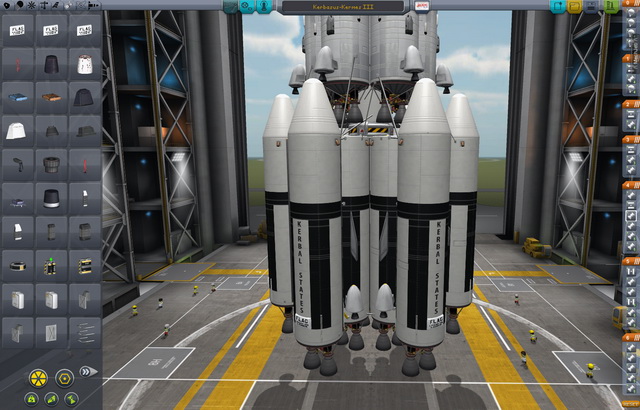
In it's final complete form, the Kerbasus-Kermes III rocket stands over 100 meters tall and weighs nearly 1000 tons. We expect that it will give Jebediah a thrilling ride to Duna and back.
Comments are disabled.
Post is locked.






Posted by: TheSquirrelPatrol at
11:47 PM
| No Comments
| Add Comment
Post contains 994 words, total size 7 kb.
14kb generated in CPU 0.0098, elapsed 0.0543 seconds.
34 queries taking 0.0477 seconds, 54 records returned.
Powered by Minx 1.1.6c-pink.
34 queries taking 0.0477 seconds, 54 records returned.
Powered by Minx 1.1.6c-pink.









